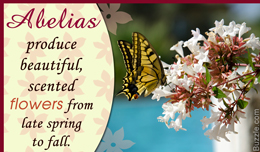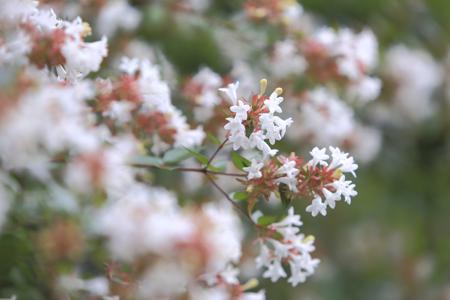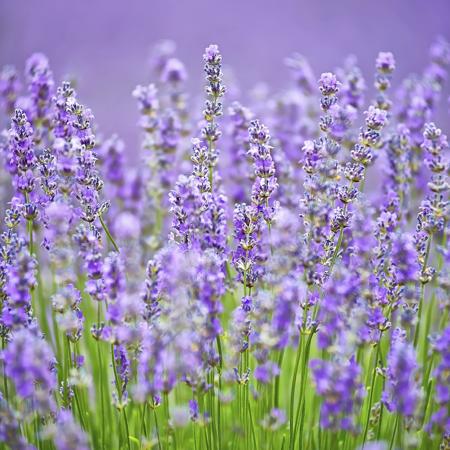





 Did You Know?Abelias are named after Dr. Clarke Abel, a surgeon who was appointed as the Chief Medical Officer to Lord Amherst's Embassy to China (1816-1817). Dr. Clarke was a keen naturalist too. Unfortunately, all the plants and seeds that he had collected in China were lost in a shipwreck when he was returning to England. Later, Scottish botanist Robert Fortune imported plants of Abelia chinensis in 1844, and of Abelia uniflora in 1849.The genus Abelia contains about 30 different species of flowering shrubs and a number of hybrids. These popular flowering plants belong to the family Caprifoliaceae (Linnaeaceae). They are native to eastern Asia (from Western Japan to the Himalayan ranges) and southern part of North America (Mexico). They are described as 'semi-evergreen shrubs', because the species that grow in colder regions are deciduous (they may lose half of the leaves in winter). Plants growing in warmer regions can be evergreen. Abelias require little or no maintenance.
Did You Know?Abelias are named after Dr. Clarke Abel, a surgeon who was appointed as the Chief Medical Officer to Lord Amherst's Embassy to China (1816-1817). Dr. Clarke was a keen naturalist too. Unfortunately, all the plants and seeds that he had collected in China were lost in a shipwreck when he was returning to England. Later, Scottish botanist Robert Fortune imported plants of Abelia chinensis in 1844, and of Abelia uniflora in 1849.The genus Abelia contains about 30 different species of flowering shrubs and a number of hybrids. These popular flowering plants belong to the family Caprifoliaceae (Linnaeaceae). They are native to eastern Asia (from Western Japan to the Himalayan ranges) and southern part of North America (Mexico). They are described as 'semi-evergreen shrubs', because the species that grow in colder regions are deciduous (they may lose half of the leaves in winter). Plants growing in warmer regions can be evergreen. Abelias require little or no maintenance. It is a hybrid of Abelia chinensis and Abelia uniflora. Both the parents are from central China. The plant is commonly known as glossy Abelia. It is the most widely grown Abelia hybrid. The arching branches can spread up to 12 feet. The shrub can be 6 to 10 feet tall. Different cultivars, for example, Edward Goucher, Canyon Creek, Kaleidoscope, Little Richard, Mardis Gras, Rose Creek, and Silver Anniversary are popular as garden plants. They produce abundant flowers from early summer to frost. The tubular white flowers have a light purple-pink tinge. The glossy, dark green leaves turn bronze-green to bronze-red in winter. The ovate leaves are 1 to 0.5 in long and are placed opposite. The colors displayed by these plants in spring and fall are outstanding.Lavender Mist
It is a hybrid of Abelia chinensis and Abelia uniflora. Both the parents are from central China. The plant is commonly known as glossy Abelia. It is the most widely grown Abelia hybrid. The arching branches can spread up to 12 feet. The shrub can be 6 to 10 feet tall. Different cultivars, for example, Edward Goucher, Canyon Creek, Kaleidoscope, Little Richard, Mardis Gras, Rose Creek, and Silver Anniversary are popular as garden plants. They produce abundant flowers from early summer to frost. The tubular white flowers have a light purple-pink tinge. The glossy, dark green leaves turn bronze-green to bronze-red in winter. The ovate leaves are 1 to 0.5 in long and are placed opposite. The colors displayed by these plants in spring and fall are outstanding.Lavender Mist It comes with gray green leaves that turn purplish red in fall and deep purple in winter. It requires less pruning as it doesn't spread vigorously. It produces lavender and white flowers. It blooms profusely in June and in August. Established plants should be pruned in early spring.Plum SurpriseIt produces comparatively less flowers. It is known for its finely textured foliage. The yellow-green leaves turn emerald in summer and burgundy in winter. The stems have a reddish tint. The arching branches bear single flowers. White petals open with a purple tinge. The flower has a yellow throat. Early spring pruning encourages good growth. Like other varieties, it also resists drought and summer heat.Mexican AbeliaAbelia floribunda is native to Mexico. It produces longer flowers than the other Abelias. The plant grows 8 to 10 feet tall and 10 to 12 feet wide. The amazing vibrant pink flowers that hang in clusters in between the glossy, green leaves increase the beauty of the plant. The leaves are relatively small and have serrated edges. It grows well in partial shade or full sun. It can withstand drought, wind, and pollution.Chinese AbeliaAbelia chinensis produces more flowers than other varieties. Branches spreading in all directions bear clusters of fragrant and frilly flowers. The tubular white flowers have red calyxes. The dark green leaves display slight maroon shade. Proper pruning can help manage the height and shape of the plant.Abelia 'Mardi Gras'This variety was developed from a mutant branch of a hybrid Abelia. It is a compact (2-3 feet tall and 3-4 feet wide), mounding shrub. Pink tinged, green, and white variegated leaves make it an attractive shrub. When they emerge, they are pink. They turn green variegated with white in spring and summer. The bush appears copper-colored in winter. Copper-red plant stems add to the beauty of the plant. Fragrant pink flowers attract bees and butterflies. The flowers have rose-colored calyces. The plant performs well when planted in partial shade.Abelia x grandiflora 'Kaleidoscope''Kaleidoscope' is the most striking, multicolor, evergreen, low-growing, compact Abelia cultivar. It can be planted in containers. It grows well in moist, well-drained, acidic soil. When used as groundcover or in borders, the plants create a striking kaleidoscope of color. Bright red stems and golden yellow variegation on green leaves impart enchanting beauty to the plant.Canyon Creek (Abelia x grandiflora)The plant can be 4 to 6 feet tall. It looks beautiful in all seasons. Color of the emerging leaves can be bronze to copper. They eventually acquire dark green color. They turn antique bronze and pink during winter. The flowers are rosy pink or white.Francis Mason (Abelia x grandiflora)It is a dwarf variety which grows up to 3 or 4 feet only. The leaves of this newer cultivar are variegated yellow with green tints or all yellow.Confetti (Abelia x grandiflora)It is a new cultivar of glossy Abelia, and is good for small spaces, as it grows up to 3 feet only. It can be about 4 feet wide. Regular pruning can give it a round shape. Its dark green leaves have creamy white and pink tinge. They may have yellow edges. The flowers are pink. The plant grows well in well-drained soil in full sun or partial shade.Little Richard (Abelia x grandiflora)This dwarf glossy Abelia is suitable for small spaces. Although it is less than half the size of standard types, it produces flowers in masses. It is a dense rounded shrub. The green leaves turn tangerine-pink in fall.Sunshine Daydream (Abelia x grandiflora)It can be 3 -3.5 feet tall and wide. Proper pruning gives it a round shape. The middle part of the leaves is green while the outer parts and borders are golden yellow and pink. It is known for pale pink flowers and multicolored foliage.Abelia Rose CreekIt can be 2-3 feet tall and 3-4 feet wide. It is compact and dense. The green lustrous leaves have a pink cast. The stems are crimson and the flowers are white and pink. The leaves turn purple green in winter. The flowers take a rose-copper color.Abelia trifloraThis plant is found in the Himalayas. It produces pink-tinged white flowers that are richly scented. It can grow up to 15 feet and can be 10 feet wide. So, it can be a small tree, and not a shrub.Abelia spathulataIt is a deciduous shrub which produces white five-stellate flowers. It is native to Japan. It can be 6-8 feet tall and 5-6 feet wide.Most consumers never notice Abelia plants or think that Abelia is an old-fashioned shrub. In fact, planting Abelias will be an asset to your yard, as these are easy-to-grow, low-maintenance shrubs that produce flowers continuously for 6-8 months. Generally, they are pest-free and do not develop any diseases. The diversity of its cultivars and the spectacular color displays are really amazing.
It comes with gray green leaves that turn purplish red in fall and deep purple in winter. It requires less pruning as it doesn't spread vigorously. It produces lavender and white flowers. It blooms profusely in June and in August. Established plants should be pruned in early spring.Plum SurpriseIt produces comparatively less flowers. It is known for its finely textured foliage. The yellow-green leaves turn emerald in summer and burgundy in winter. The stems have a reddish tint. The arching branches bear single flowers. White petals open with a purple tinge. The flower has a yellow throat. Early spring pruning encourages good growth. Like other varieties, it also resists drought and summer heat.Mexican AbeliaAbelia floribunda is native to Mexico. It produces longer flowers than the other Abelias. The plant grows 8 to 10 feet tall and 10 to 12 feet wide. The amazing vibrant pink flowers that hang in clusters in between the glossy, green leaves increase the beauty of the plant. The leaves are relatively small and have serrated edges. It grows well in partial shade or full sun. It can withstand drought, wind, and pollution.Chinese AbeliaAbelia chinensis produces more flowers than other varieties. Branches spreading in all directions bear clusters of fragrant and frilly flowers. The tubular white flowers have red calyxes. The dark green leaves display slight maroon shade. Proper pruning can help manage the height and shape of the plant.Abelia 'Mardi Gras'This variety was developed from a mutant branch of a hybrid Abelia. It is a compact (2-3 feet tall and 3-4 feet wide), mounding shrub. Pink tinged, green, and white variegated leaves make it an attractive shrub. When they emerge, they are pink. They turn green variegated with white in spring and summer. The bush appears copper-colored in winter. Copper-red plant stems add to the beauty of the plant. Fragrant pink flowers attract bees and butterflies. The flowers have rose-colored calyces. The plant performs well when planted in partial shade.Abelia x grandiflora 'Kaleidoscope''Kaleidoscope' is the most striking, multicolor, evergreen, low-growing, compact Abelia cultivar. It can be planted in containers. It grows well in moist, well-drained, acidic soil. When used as groundcover or in borders, the plants create a striking kaleidoscope of color. Bright red stems and golden yellow variegation on green leaves impart enchanting beauty to the plant.Canyon Creek (Abelia x grandiflora)The plant can be 4 to 6 feet tall. It looks beautiful in all seasons. Color of the emerging leaves can be bronze to copper. They eventually acquire dark green color. They turn antique bronze and pink during winter. The flowers are rosy pink or white.Francis Mason (Abelia x grandiflora)It is a dwarf variety which grows up to 3 or 4 feet only. The leaves of this newer cultivar are variegated yellow with green tints or all yellow.Confetti (Abelia x grandiflora)It is a new cultivar of glossy Abelia, and is good for small spaces, as it grows up to 3 feet only. It can be about 4 feet wide. Regular pruning can give it a round shape. Its dark green leaves have creamy white and pink tinge. They may have yellow edges. The flowers are pink. The plant grows well in well-drained soil in full sun or partial shade.Little Richard (Abelia x grandiflora)This dwarf glossy Abelia is suitable for small spaces. Although it is less than half the size of standard types, it produces flowers in masses. It is a dense rounded shrub. The green leaves turn tangerine-pink in fall.Sunshine Daydream (Abelia x grandiflora)It can be 3 -3.5 feet tall and wide. Proper pruning gives it a round shape. The middle part of the leaves is green while the outer parts and borders are golden yellow and pink. It is known for pale pink flowers and multicolored foliage.Abelia Rose CreekIt can be 2-3 feet tall and 3-4 feet wide. It is compact and dense. The green lustrous leaves have a pink cast. The stems are crimson and the flowers are white and pink. The leaves turn purple green in winter. The flowers take a rose-copper color.Abelia trifloraThis plant is found in the Himalayas. It produces pink-tinged white flowers that are richly scented. It can grow up to 15 feet and can be 10 feet wide. So, it can be a small tree, and not a shrub.Abelia spathulataIt is a deciduous shrub which produces white five-stellate flowers. It is native to Japan. It can be 6-8 feet tall and 5-6 feet wide.Most consumers never notice Abelia plants or think that Abelia is an old-fashioned shrub. In fact, planting Abelias will be an asset to your yard, as these are easy-to-grow, low-maintenance shrubs that produce flowers continuously for 6-8 months. Generally, they are pest-free and do not develop any diseases. The diversity of its cultivars and the spectacular color displays are really amazing.
Copyright © www.100flowers.win Botanic Garden All Rights Reserved